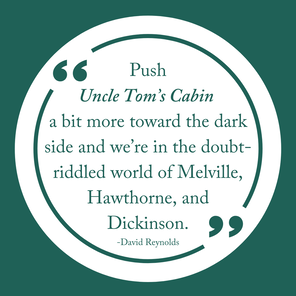 Herman Melville, Moby Dick and "Benito Cereno" Herman Melville was a New Yorker who went to sea, and Harriet Beecher Stowe was a New Englander who spent eighteen important years in Cincinnati. It’s unlikely that Harriet read Melville’s books, and Melville may have read Uncle Tom’s Cabin but only after writing Moby-Dick. Still, these two authors have more in common than you might think. Both were raised in Calvinist households, Melville in the Dutch Reformed Church and Harriet in her father’s Presbyterianism. Both also later switched to churches with more optimistic theologies, Melville to Unitarianism and Harriet to the Episcopal Church. Scholar David Reynolds suggests that the gloomy Calvinist background and the spiritual questioning that followed account for the surprising number of characters who question their faith in Uncle Tom’s Cabin: “Push Uncle Tom’s Cabin a bit more toward the dark side and we’re in the doubt-riddled world of Melville, Hawthorne, and Dickinson.” The year 1851 was central to the writing lives of both Harriet and Melville. She began serial publication of Uncle Tom’s Cabin, and he published Moby-Dick. Both authors followed these works with important fictional treatments of slavery in the mid-1850s: Melville with his novella “Benito Cereno” in 1855 and Harriet with her novel Dred: A Tale of the Great Dismal Swamp the next year. The two authors’ very different approaches to writing made both their critical and popular reputations as volatile as today’s stock market. Harriet’s direct condemnation of slavery in Uncle Tom’s Cabin made it the bestselling book in the world other than the Bible in the nineteenth century, while Melville’s dense language, irony, and ambiguous symbolism in Moby-Dick attracted few readers in his lifetime. His contemporaries also were not ready for the close crosscultural friendship of Ishmael and Queequeg or Melville’s implicit critique of American white supremacy when Ishmael says: “It was the whiteness of the whale that above all things appalled me.” Even when Melville dealt explicitly with slavery in “Benito Cereno,” his irony and complex character development were too indirect to interest abolitionists or many other readers. When Melville and Harriet died in the 1890s, she was by far the more famous of the two. By the 1920s, literary tastes were changing. Critics began to celebrate Melville’s psychological analysis and thematic ambiguities and turned away from what they considered the propaganda and sentimentality of Uncle Tom’s Cabin. Then, starting in the early 1980s, feminist criticism and cultural studies brought Uncle Tom’s Cabin back into the literary canon, where it stands today alongside Moby-Dick as one of the central works of mid-nineteenth century American literature. About the author:
Dr. John Getz, Professor Emeritus, Xavier University, retired in 2017 after teaching English there for 45 years. He specializes in American literature, especially nineteenth century, as well as the intersections of literature and peace studies. He has written articles on a variety of authors including Edith Wharton, Sherwood Anderson, and Ursula Le Guin. He appears in the documentary film Becoming Harriet Beecher Stowe, scheduled for release in 2020 by Fourth Wall Films.
2 Comments
Daniel McLoughlin
7/7/2020 12:32:23 pm
Thank you John!
Reply
Cheli reutter
6/10/2021 10:05:11 pm
This is a great discussion starter.
Reply
Leave a Reply. |
Archives
March 2025
Categories
All
|
|

 RSS Feed
RSS Feed